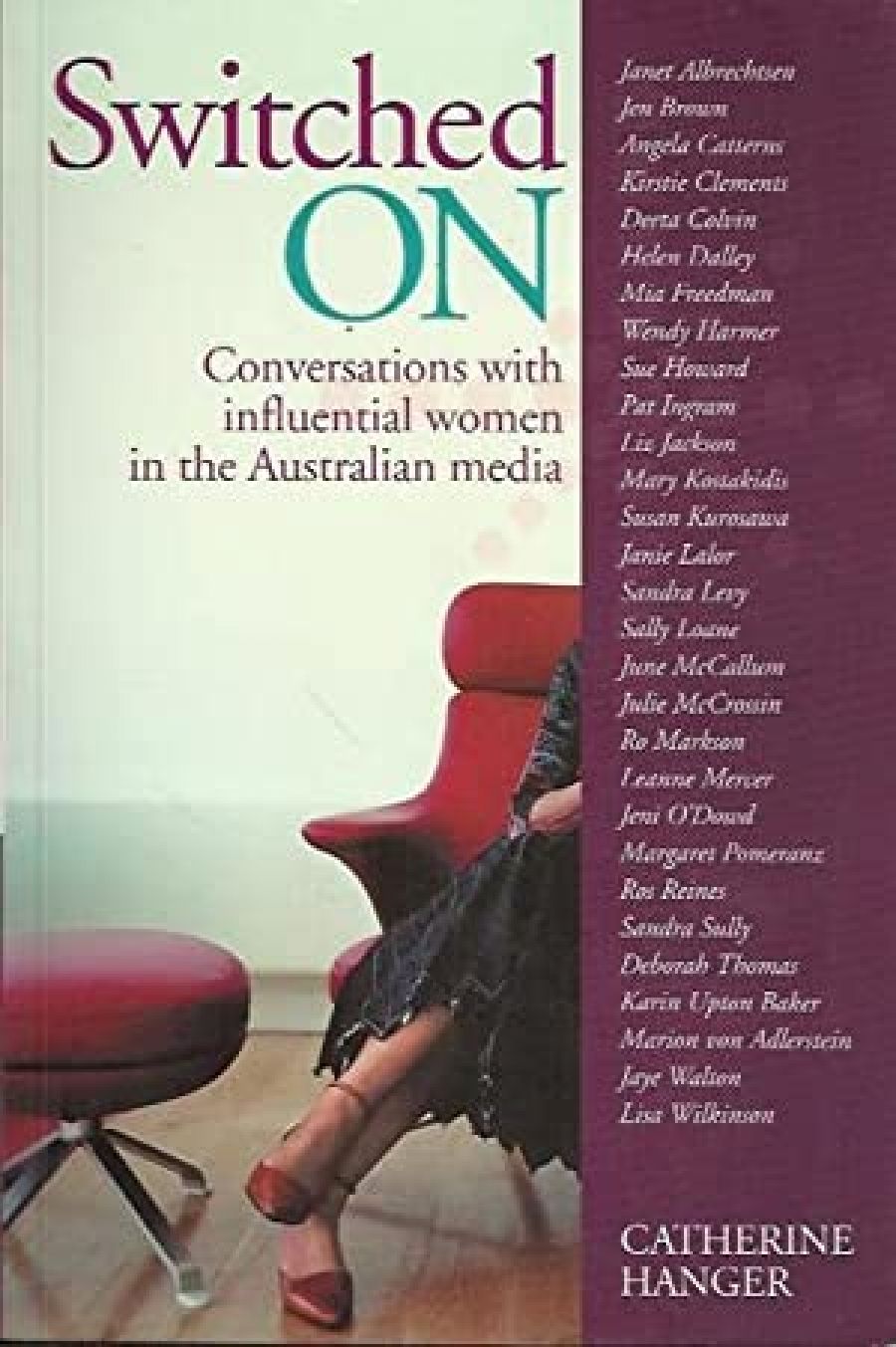
- Free Article: No
- Contents Category: Media
- Review Article: Yes
- Online Only: No
- Custom Highlight Text:
Switched On showcases the careers of twenty-nine ‘influential’ women who work in the media. Catherine Hanger, interviewer and former editor of Vogue Australia, believes that Switched On ‘connects two major spheres of influence in our society – the media and the women who work in it’ – and argues that the influence of these women is ‘very powerful indeed’. While the title promises ‘conversations’, Hanger, strangely, omits her questions. Perhaps she asked just one: ‘How did you become editor of Australian Women’s Weekly/an SBS news presenter/a film reviewer/a PR adviser to PBL/host of Media Watch?’
- Book 1 Title: Switched On
- Book 1 Subtitle: Conversations with influential women in the Australian media
- Book 1 Biblio: John Wiley, $29.95 pb, 247 pp
What lessons would a young woman hoping to embark on a career in the media take from this book? Having a clear objective in mind seems to help (Mia Freedman: ‘My aim was very much to be editor of Cleo by the time I was 25’); as does persistence (Mary Kostakidis: ‘I’ve always been the kind of person who doesn’t exactly knock politely on doors, I give them a good shake’). Many of the women demonstrate extraordinary resilience: newsreader Sandra Sully, a self-described ‘survivor’, tells how the Channel Ten crew knew she was axed before she did and how the ‘network loved the publicity’ when a failed dress rehearsal led her to expose an ‘uncomfortable’ amount of cleavage. Her guiding principle (‘I never said no’) is echoed throughout Switched On.
The strain of being a working mother is often mentioned and is almost refreshing after the upbeat, uncomplicated and unrealistic work-your-bum-off-and-feel-great-about-it ‘feminist’ message that pervades the book. ABC radio broadcaster Sally Loane describes the boss’s response to her first pregnancy (‘a disaster’). Public relations consultant Ro Markson does a PR job on her life and the working-mother image; she happily describes her daily routine of going without a lunch break, leaving work at 3.15 p.m. and returning when the children are ‘settled’. I felt exhausted reading this account, particularly when Markson throws ambiguity to the wind: ‘the kind of people I have recruited are extremely bright, extremely motivated, extremely passionate … they are extremely close and extremely supportive.’
While SBS didn’t blink when Kostakidas started going grey, commercial media groups have no time for loyalty. Janet Albrechtsen, whom Hanger describes as ‘the opinion maker’, is all for ‘market flexibilty’; when her father lost his job as a result of Paul Keating’s ‘restructuring’, she ‘respected’ Keating for it. Telling how she was rejected by an Adelaide law firm because she didn’t go to the ‘right’ school, Albrechtsen relays, without a hint of self-consciousness, how things began to fall into place when she married a partner at Freehills and became friendly with the mother of another child at her daughter’s school, who happened to be a Herald journalist.
For a small dose of Absolutely Fabulous, without the laughs, there are eight conversations with women who work in women’s magazines. Former Vogue editor Karin Upton Baker, who describes herself as a ‘challenge junkie’, says she is sure many people think of her as a ‘ferocious bitch’, but she doesn’t care. Kirstie Clements, of Vogue Australia, says that she thought working for the magazine as a receptionist would be ‘amazing’, since she loved the world of ‘fashion, beauty and photography’: ‘what girl doesn’t?’
Certainly, nobody should discount the influence that magazines such as Vogue, Cleo, Cosmopolitan, Dolly and the Australian Women’s Weekly have on women’s lives. They respond to a desire women have to be entertained, instructed and informed; Deborah Thomas describes the ‘softly, softly’ approach of the Weekly, which asked, ‘is it the Australian way to lock up children?’ Editors speak of their responsibility to provide accurate and empowering information, yet many still present an image of beauty that is, for the vast majority of women, completely unattainable. Upton Baker says, on the issue of ‘skinny models’: ‘some of them are anorexic and some of them eat like horses … I’m not prepared to be apologetic about it.’ But Wilkinson became committed to opening up ‘meaningful dialogue’ with girls after perceiving that Dolly had been ‘squandering’ girls’ trust on ‘body and self-esteem issues’.
How much influence do women in the media really have? Margaret Pomeranz’s move from SBS to the ABC demonstrates that it is possible to use one’s limited influence to maintain important principles. Real influence means shaping society in ways you think best, rather than simply implementing an entrenched approach. Thomas’s strong support for maternity leave is an example of this, as was Liz Jackson’s interview with John Howard on the ‘children overboard’ affair. Yet Wendy Harmer’s account of being sacked after eleven years at 2DAY FM because her high ratings ‘only’ reflected the taste of women over thirty-nine reminds us that real power lies elsewhere. Switched On professes an interest in those that are ‘very powerful indeed’. They, however, are not Hanger’s subjects.


Comments powered by CComment